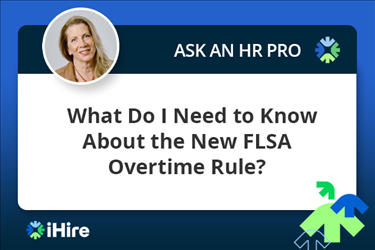- Employer Resources
- |
- Last Updated: December 05, 2023

5 Mistakes to Avoid When Making a Job Offer
Today's job market is highly competitive for employers and employees alike. In fact, according to iHire’s 2023 State of Online Recruiting Report, 62.6% of companies said they receive too many unqualified applicants and 43.1% struggled with receiving too few applicants.
The changing demand for what candidates want has also put a lot of heat on the hiring market. Workplaces must learn to adapt to these differences or miss out on securing top talent. Employees have begun realizing the benefits remote, hybrid, and flexible work offer and would prefer a better work-life balance. Another factor employees often consider is company culture, with 46% of job seekers influenced by a company's culture and 15% stating a poor company culture is a deal breaker.
But what does that mean for you and your mission to secure top talent? It's important that you get your job offer right. If you're looking for advice on how to offer someone a job, look no further than these five job offer mistakes to avoid.
5 Job Offer Mistakes to Avoid
As someone looking to hire new talent but has come up empty-handed, you might wonder why candidates reject job offers. Even if they've verbally accepted, sometimes candidates will later reject a written offer.
Below are several common mistakes that can lead to candidates rejecting job offers and how to avoid them.
1. Excluding Important Information
It's tempting to keep job offers short and simple. Your job listing and interview processes probably went over all the important information. However, you should still have all the information listed in the job offer letter to make it easier for your prospective employee to go back to and reflect on it.
Include details like the job title, hours, an overview of any primary job responsibilities, expected start date, job location, and pay rate and frequency. List benefits such as healthcare, bonuses, 401(k), and paid vacation time. Include any growth opportunities or background on your company's culture to further pique (and hold) your candidate's interest.
Lastly, make it clear if hybrid work, remote work, or flexibility is allowed.
2. Setting a Job Offer Expiration That Is Too Long or Too Short
You're excited to get the ball rolling and want your prospective employee to review and accept the job offer as soon as possible, but it can do more harm than good to set a short deadline. Rushing your candidate can actually have a negative effect. It may make them reject your offer because it doesn't give them enough time to figure out if your job aligns with their career goals and personal circumstances.
On the other hand, providing your prospective employee with too much time or no deadline at all can cause a delay in fulfilling your role. If there's no deadline, there's no incentive to get back to you, and your candidate may take their time shopping for other offers they may like better.
Set a deadline of around 4 to 5 days. This will allow your prospective employee enough time to evaluate the job offer and also keep you from being strung along.

3. Offering Your Top Offer From the Start
You may think sending your best offer is the right way to go and will expedite the hiring process when making a job offer. But that's not always the case. When you start with your top offer, you unintentionally skip over the chance for a healthy back-and-forth, which can lead to a more satisfying employment agreement for both sides. By laying it all out from the get-go, you might miss out on addressing your prospective employee's unique concerns and aspirations, potentially causing them to walk away from the offer. It turns into a lose/lose situation.
A better approach to how to offer someone a job is to make an offer that leaves room for negotiations. Encourage open communication and allow your candidate to voice their concerns and preferences. This will show your candidate you care and can build a positive working relationship. You don't need to give into all of your candidate's demands, but meeting them halfway may be the deciding factor in whether they accept your job offer or not.
4. Not Offering Enough
Traditionally, candidates were happy with competitive wages, health insurance, and a pension plan. However, employee expectations have changed. That's not to say you have to offer them the moon and the sky, but offer things like tuition reimbursement, hybrid work, and wellness plans that include gym memberships and yoga sessions. These can contribute to a good work-life balance, which has become an increasing employee demand.
In today's competitive job market, these extra perks can make a significant difference in attracting and retaining top talent. Candidates value employers who invest in their personal and professional well-being, making it crucial for companies to adapt to these changing expectations to remain competitive and appealing to potential hires.
Create Your Account Today
5. Being Unavailable for Questions
After offering a job to a candidate, expect a follow-up with questions. It won't always happen, but it might, and you need to be there when it does to answer them. When your candidate reaches out with questions, it means they're interested in your job offer and want to know more. Perhaps something was confusing in your original offer and your candidate wants clarification, or maybe they have a question about something not in the offer.
Transparency is key in securing the best talent. While it's not expected for you to be available at all hours of the day, it's important to be there during business hours. If you're unable to check your email during these hours, provide your candidate with another method of contact.
Your Path to Successful Job Offers
Writing a job offer becomes easier once you figure out how to offer someone a job. Make sure to include important information, set an appropriate deadline, and offer enough to interest your potential candidate while leaving room open for negotiations. A job offer that follows these steps is more likely to be accepted than one that is rushed or inflexible. Don't forget to answer your candidate's questions to show them you value transparency.
If you could use more guidance on hiring your next candidate or aren't sure how to proceed after your candidate has rejected your job offer, iHire can help. Explore our Resource Center for additional tips, or learn more about our HR Services & Consulting team. iHire's experts can help you through every phase of the hiring process (and beyond).




